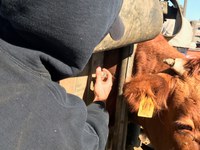Review Cow, Calf Vaccination Plans Now
(Click the image below to view a high-resolution image that can be downloaded)
Now would be a good time for cattle producers to review their animal vaccination plans, according to Gerald Stokka, North Dakota State University Extension Service veterinarian.
“The term ‘vaccination’ comes from the Latin term vaccinus, which means of or from the cow,” he notes. “The relationship of this term to vaccination results from the effort to prevent smallpox in the human population.
“It was observed that people with contact to cows with lesions due to the cowpox virus were significantly less likely to contract the highly contagious and serious human disease known as smallpox,” Stokka adds. “Vaccination just refers to the act or procedure of administering a vaccine.”
Preventing infectious disease through planned vaccination strategies is critical to every cattle operation, he says. Producers should develop vaccination strategies in consultation with their veterinarian, and those strategies should be risk-based, researched and reviewed annually.
Here are three principles producers should consider when implementing vaccination protocols:
- Necessity - Is the risk of exposure high enough that clinical disease and pathogen transmission will become a health and well-being issue beyond their expectations for the herd?
- Efficacy - Does scientific evidence or observational experience indicate that vaccine selection for specific pathogens is effective for the level of exposure and stress of the herd?
- Safety - Does evidence indicate that the vaccination will not cause harm through local or systemic reactions?
“The result of considering these principles is that vaccination protocols become relatively short, can be defended and are used in the proper circumstances at the proper time,” Stokka says.
Vaccination of beef calves weaned early this summer and fall should adhere to these principles.
What’s Necessary in Calf Vaccination Protocols?
“Viral vaccines are necessary because no other management tools are available to treat or prevent virus infections that contribute to respiratory disease in beef calves,” Stokka says.
In northern Plains beef herds, the viruses BRSV (bovine respiratory syncytial virus), IBR (infectious bovine rhinotracheitis) and PI3 (parainfluenza 3) appear to be widespread. Cow herds vaccinated for or exposed to these viruses will provide some protection to young nursing calves through passive immunity transferred shortly after birth. However, this protection will wane when the calves are about 3 to 4 months of age, and they can be at risk.
Research indicates that intranasally administered vaccines in young calves can enhance protection, even when maternal immunity is high. The primary dose of virus vaccine should contain these viruses and be administered via the intranasal route.
The BVDV (bovine virus diarrhea virus) pathogen is a concern, but in beef herds that practice annual cow herd vaccination, the risk to young calves is reduced and vaccination can be delayed until weaning.
The second dose, which should be given prior to or at weaning, can be administered parenterally (labeled as subcutaneous or intramuscular). It will booster the response to the viruses that previously were administered intranasally.
Common vaccination protocols include products combined to contain four to five viruses and a bacterial fraction. These are best administered as the second, or booster, dose.
Which Vaccines to Use
Vaccination plans for the breeding herds with annual viral vaccinations should include pre-breeding (30 days prior to breeding) modified live vaccines containing IBR, BRSV and BVDV, along with a five-way leptospirosis fraction and campylobacter (vibrio).
Stokka recommends that if these are administered in the fall at pregnancy checking time, producers should use an inactivated virus vaccine with five-way leptospirosis. If administering a modified live virus vaccine to pregnant cows, producers should check with their veterinarian to make sure the vaccine is being used according to label directions.
This is what to use during grass turnout time or for a preweaning initial vaccination:
- Modified live virus vaccine containing BRSV, IBR and PI3 administered intranasally
- Clostridial vaccine, seven- or eight-way administered subcutaneously
Use for preweaning, weaning or post-weaning as a second (booster) dose:
- Modified live virus vaccine containing BRSV, IBR, PI3 and BVDV (type 1 and 2) administered subcutaneously (can be in combination or separately with a bacterial fraction containing leukotoxin to Mannheimia hemolytica)
- Clostridial vaccine, booster dose, seven- or eight-way administered subcutaneously
For herds without an annual viral cow herd vaccination, use the following for turnout time or a preweaning initial vaccination:
- Modified live virus vaccine containing BRSV, IBR and PI3 administered intranasally
- Modified live virus vaccine containing BVDV (types 1 and 2) administered parenterally (can be in combination or separately with a bacterial fraction containing leukotoxin to Mannheimia hemolytica in herds with history of nursing calf pneumonia)
- Clostridial vaccine, seven- or eight-way administered subcutaneously
For herds without an annual viral cow herd vaccination, use the following for weaning or post-weaning as second (booster) dose:
- Modified live virus vaccine containing BRSV, IBR, PI3 and BVDV (types 1 and 2) (can be administered in combination or separately with a bacterial fraction containing leukotoxin to Mannheimia hemolytica)
- Clostridial vaccine, seven- or eight-way administered subcutaneously
“Make sure you are consulting with your veterinarian on vaccine strategies and handling,” Stokka advises. “Your operations are unique and will need recommendations tailored to your operation.”
NDSU Agriculture Communication - Oct. 5, 2017
| Source: | Gerald Stokka, 701-231-5082, gerald.stokka@ndsu.edu |
|---|---|
| Editor: | Ellen Crawford, 701-231-5391, ellen.crawford@ndsu.edu |


